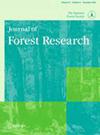A pilot study on home range of female Chinese goral ( Naemorhedus griseus ): exploring GPS tracking data in a cliff landscape
IF 1.1
4区 农林科学
Q3 FORESTRY
引用次数: 0
Abstract
ABSTRACTHome range size estimation is an important basis for developing effective conservation strategies and provides important insights into the study of animal behavior and spatial ecology. We analyze home range variations and the fitfulness of estimation methods on Chinese gorals (Naemorhedus griseus) living at a cliff landscape with GPS tracking data. We report annual, seasonal, and monthly home range sizes of five female Chinese gorals tracked from February 2015 to September 2018. We found variations existed in 95% seasonal home range sizes among estimation methods. We recommend that the α-LoCoH model be used in home range estimations, as this model appeared to more accurately reflect animal locations within the steep cliff habitat in our study area. Furthermore, more animals should be GPS tracked to ensure the validity of any interpretation concerning their home range size in a rugged habitat. This study was the first conducting home-range GPS tracking of Chinese gorals in their northern distribution range. Additionally, our findings provided previously unknown information regarding the home range traits of this endangered species, and they may contribute to the development of effective conservation strategies.KEYWORDS: Chinese goralhome rangeminimum convex polygonkernel density estimationα-local convex hull AcknowledgementsWe would like to extend our gratitude to all the staff in the Inner Mongolia Saihanwula National Nature Reserve for their valuable support in helping us capture and collar the animals, as well as maintaining the habitats. We thank the coordinator editor and two anonymous reviewers for their insightful comments on the original manuscript.Disclosure statementNo potential conflict of interest was reported by the authors.Additional informationFundingThis work was supported by the National Forestry and Grassland Administration (No. 20141123).山崖景观中中国山猫(Naemorhedus griseus)母系活动范围的初步研究:GPS追踪数据的探索
栖息地大小估算是制定有效保护策略的重要依据,为动物行为和空间生态学研究提供了重要见解。利用GPS跟踪数据,分析了崖景中国野鸭(Naemorhedus griseus)的家程变化及其估计方法的适应性。我们报告了从2015年2月到2018年9月追踪的5只中国雌性大猩猩的年度、季节性和月度范围。我们发现在95%的估计方法中存在季节性家庭范围大小的差异。我们建议α-LoCoH模型用于家园范围估计,因为该模型似乎更准确地反映了我们研究区域陡峭悬崖栖息地的动物位置。此外,应该对更多的动物进行GPS跟踪,以确保在崎岖的栖息地中对它们的活动范围大小进行任何解释的有效性。本研究是首次对中国野狗在其北部分布范围内进行本土GPS跟踪研究。此外,我们的研究结果提供了关于这种濒危物种的栖息地特征的未知信息,并可能有助于制定有效的保护策略。感谢内蒙古赛罕乌拉国家级自然保护区的所有工作人员,感谢他们在帮助我们捕捉、圈养和维护栖息地方面给予的宝贵支持。我们感谢协调编辑和两位匿名审稿人对原稿的深刻评论。披露声明作者未报告潜在的利益冲突。本研究由国家林业和草原局(20141123)资助。
本文章由计算机程序翻译,如有差异,请以英文原文为准。
求助全文
约1分钟内获得全文
求助全文
来源期刊

Journal of Forest Research
农林科学-林学
CiteScore
3.00
自引率
6.70%
发文量
62
审稿时长
3 months
期刊介绍:
Journal of Forest Research publishes original articles, reviews, and short communications. It covers all aspects of forest research, both basic and applied, with the aim of encouraging international communication between scientists in different fields who share a common interest in forest science.
 求助内容:
求助内容: 应助结果提醒方式:
应助结果提醒方式:


